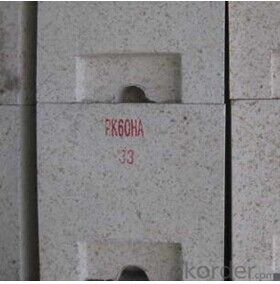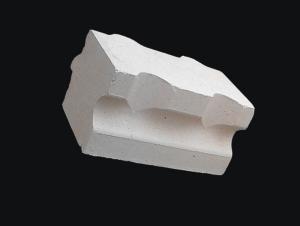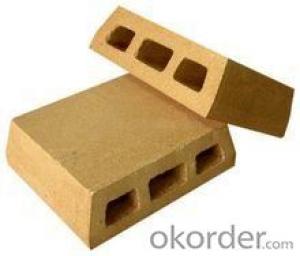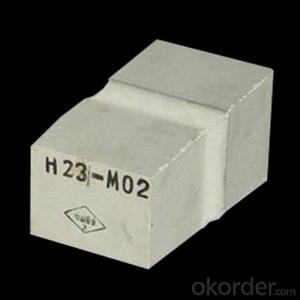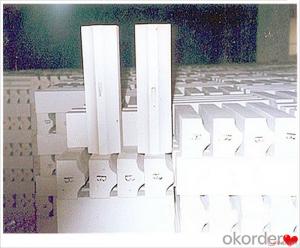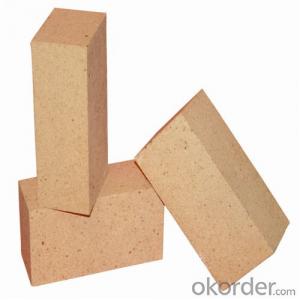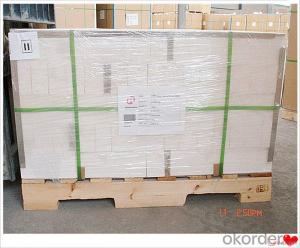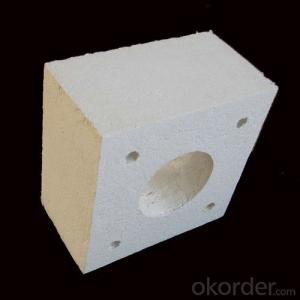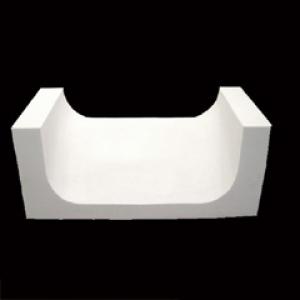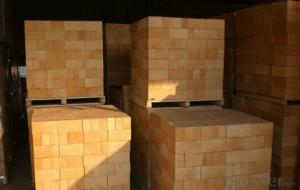Low Creep Andalusite Fused Cast Bricks
- Loading Port:
- China Main Port
- Payment Terms:
- TT OR LC
- Min Order Qty:
- -
- Supply Capability:
- -
OKorder Service Pledge
OKorder Financial Service
You Might Also Like
Description: Made from Mullite and andalusite as starting materials, the bricks are processed into shapes by moulding under high pressure and sintering are high temperature, with feature of lower impurity contents, low porosity ,low bulk density,strong strength at high temperature,steady bulk at high temperature,high thermal shock resistance and small creep rate,which are mainly used for HBS.
Brand Index | LHZ-150 | LHZ-145 | LHZ-140 | LHZ-135 |
Al2O3, % ≥ |
|
|
|
|
Fe2O3, %, ≥ | 1.0 | 1.0 | 1.3 | 1.3 |
AP, % ≤ | 1810 | 1810 | 1790 | 1790 |
BD, g/cm³ ≥ |
|
|
|
|
Refractoriness, °C ≥ |
|
|
|
|
CCS, MPa ≥ | 65(55) | 65(55) | 70(60) | 70(60) |
0.2MPa RUL, °C ≥ | 1650 | 1650 | 1630 | 1600 |
PLC(1500°C x 5h), % | 0~+0.5 | 0~+0.5 | 0~+0.5 | 0~+0.5 |
Thermal shock resistance, | 30 | 25 | 25 | 20 |
Creep rate, % ≤ | 0.8 (1500°Cx50h) | 0.8 (1450°Cx50h) | 0.8 (1400°Cx50h) | 0.8 (1400°Cx50h) |
Specifications
1,Low Creep andalusite brick
2,Resisting high temperature.
3,Great bulk density.
4,Low iron content.
- Q: How can the silica in zircon sand be removed during the smelting of zirconium corundum?
- How can the silica in zircon sand be removed during the smelting of zirconium corundum?The fused zirconia corundum brick is mainly made of fused zirconia and corundum. ZrO2-Al2O3-SiO2 three element system fused brick, containing Al2O3:40% to 50%, ZrO2:30% to 50%, SiO2:10% to 17%.
- Q: What is brick power, half brick power and full brick power difference?
- All brick power up to 500 watts up and down. The internal circuit is tight and heating, the device has good adhesion, the circuit is more advanced, and the efficiency is high, so it can achieve small size and high power.
- Q: How are qualitative and qualitative refractories understood?
- Unshaped refractory products, referred to as bulk loading, are made at the place of use for the required shapes and for heat treatment, such as castable, ramming, projection, spray, refractory clay, etc..
- Q: Zirconium corundum 25 content and 40 content, how to distinguish in appearance?
- Fused zirconia corundum brick is also called AZS AZS English is abbreviated to AZS, is based on three chemical composition of Al2O3 - Zr02 - Sio2 phase diagram of three component system, according to the content of the order, Al2O3 A, Zr02 Z, Sio2 S, national standards for the use of this abbreviation, such as No. 33 cast brick, abbreviated as AZS, 33#, No. 36 fused zirconium corundum brick, abbreviated as AZS, 36#, No. 41 fused zirconium corundum brick, abbreviated as AZS - 41#.
- Q: What is the face brick
- You should be talking about refractory bricksThe refractory brick brick. Referred to as refractory material has a certain shape and size. According to the preparation process can be divided into bricks, brick, electric melting brick, refractory insulating bricks (Rong Zhuzhuan);
- Q: Just what is in the furnace material?
- It can be used as high temperature building materials and structural materials for construction kilns and various thermal equipments, and can undergo various physical, chemical and mechanical changes at high temperature. For example, refractory clay brick, high alumina brick, brick, brick etc..
- Q: What are the specifications for bricks?
- In a proper ratio of lime sand brick and quartz sand, sand or fine sand, the ground, Kazumi Wa, semi dry pressing and autoclaved curing and. The fly ash brick is made of fly ash as main raw material and mixed with cement material such as coal gangue, stone powder or clay. It is made up of batching, molding, drying and roasting. It can make full use of industrial waste residue and save fuel.
- Q: Outside wall tile (whole body smooth surface has small hole split brick) has cement pollution, with what product cleaning (cement, mortar, cleaning agent)?
- Tile has a long period of cement pollution, a variety of weak acid cleaning can be removed, such as oxalic acid, acetic acid and so on, of course, the use of special cleaning agent is perfect. But the cost is higher.
- Q: Can the fire clay be reused?
- Refractory soil cannot be reused.Clay refractory soil 1, characteristics and uses: Clay refractory brick is a weak acid refractory material, its thermal stability is good, suitable for hot air furnace, all kinds of boiler lining, and flue, smoke room, etc.. 2, product specifications form: standard shape, general, special-shaped and special-shaped brick. Physical and chemical properties of fireclay bricks.
- Q: What's the weight of the refractory bricks?
- Referred to as refractory brick. Refractory made from refractory clay or other refractory material. Light yellow or brownish. The utility model is mainly used for laying smelting furnaces, and can withstand high temperature between 1580 DEG C and 1770 DEG C. Also called brick. Refractory material of a certain shape and size. According to the preparation process can be divided into bricks, brick, electric melting brick (Rong Zhuzhuan), the refractory insulating bricks; according to the shape and size can be divided into standard brick, brick, brick and other specific type. It can be used as high temperature building materials and structural materials for construction kilns and various thermal equipments, and can undergo various physical, chemical and mechanical changes at high temperature. For example, refractory clay brick, high alumina brick, brick, brick etc..
Send your message to us
Low Creep Andalusite Fused Cast Bricks
- Loading Port:
- China Main Port
- Payment Terms:
- TT OR LC
- Min Order Qty:
- -
- Supply Capability:
- -
OKorder Service Pledge
OKorder Financial Service
Similar products
Hot products
Hot Searches
Related keywords

